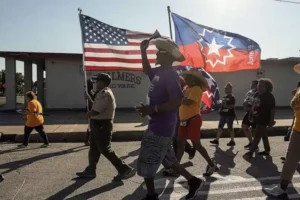By Roy Douglas Malonson
“So, you have two types of Negro. The old type and the new type. Most of you know the old type. When you read about him in history during slavery he was called ‘Uncle Tom’. He was the house Negro. And during slavery you had two Negroes. You had the house Negro and the field Negro.”
– Malcolm X
In 1965, when Dr. Martin Luther King, Jr. was jailed for the March on Selma, Malcolm X delivered a prolific rendition to a group of protestors in Selma.
He explained the differences between the house Negro and the field Negro as it was during the days of slavery. Pointing out the characteristics of both, he paralleled the same type of personality that existed in slavery to that which was demonstrated by Black folks during his day (1965).
He explained how the house Negro lived close to his Master, dressed like him, ate his leftovers and even identified himself like the Master.
The field Negro then, was the exact opposite. He stayed out in the field working from sun up to sun down. He cared more about the things that happened to affect all slaves, whereas the house Negro was only concerned about himself and those things which pertained to the Master.
During slavery the vast majority of slaves were field Negroes. Malcolm X continued to explain various other differences between the two type of Negroes that existed during slavery.
As he moved towards his era. He said, “So now you have a twentieth-century-type of house Negro. A twentieth-century Uncle Tom. He’s just as much an Uncle Tom today as Uncle Tom was 100 and 200 years ago. Only he’s a modern Uncle Tom.
That Uncle Tom wore a handkerchief around his head. This Uncle Tom wears a top hat. He’s sharp. He dresses just like you do. He speaks the same phraseology, the same language.
He tries to speak it better than you do… So, this is the twentieth-century Negro. Whenever you say ‘you,’ the personal pronoun in the singular or in the plural, he uses it right along with you. When you say you’re in trouble, he says, ‘Yes, we’re in trouble.’”
After Malcolm X spoke those words, he concluded by saying, “But there’s another kind of Black man on the scene. If you say you’re in trouble, he says, ‘Yes, you’re in trouble.’ He doesn’t identify himself with your plight whatsoever.”
After reflecting on Malcolm X’s speech in its entirety, I wondered to myself what he would think about many of these modern-day Negroes?
Because truth is, the way society has evolved it ain’t very many field Negroes around no more. All of the field Negroes have become house Negroes and nowadays it ain’t nobody hardly left to fight.
Many of them have abandoned their communities and moved into others which was never truly designed for them. They have left a lot of their old landmarks in search of better opportunities, not realizing that they have neglected their own.
You see, back in the day it was the field Negroes who fought vicariously for ALL Negroes. They were the ones who made the way for the house Negroes and the Uncle Tom’s.
But even though some things have changed, still a lot of things remain the same. Hence, Same Principle, Different Generation.
Concluding, We MUST Understand in 2019, there is a new House Negro on the scene. The only difference, his ancestors are not from Africa, but instead Mexico; his skin is not as dark as the original House Negro and chances are English is not his primary language.
But you can rest assured that he is out working to provide for his family locally and internationally. There is no task that is too difficult for him to accept either.
Photo credit: historyextra.com










